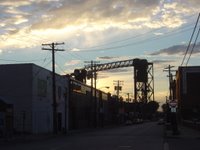Making Sense of Cleveland
On Wednesday, Cleveland's PBS affiliate debuted the documentary in the latest Lincoln Institute's Making Sense of Place series, Cleveland: Confronting Decline in an American City.
Confronting Decline like the first film in the series, Phoenix: The Urban Desert, "seeks to educate and inspire citizens to engage in a better-informed civic dialogue about social equity, diversity and economic opportunity. The goal is to promote this dialogue across a wide range of residents, policymakers, elected officials, civic leaders, advocates, activists and opinion leaders, by providing information and context for future planning in Greater Cleveland's growth and revitalization. While Cleveland is the case study in this film, the personal stories and narrations about the forces that shape current growth patterns are applicable to many other cities and regions across the country."
This one-hour documentary puts much focus on the periodic decline of the center city, the recent plague of widespread no-growth sprawl, inclinations of much of the population towards urbanism (manifest in new "urban" lifestyle centers), the decline of the area's first suburbs that resident and retail populations have left behind, and the implementation of counter-measures (such as residential and industrial land banks, brownfield cleanup, land conservancies and economic restructuring) that have become national examples.
The film describes center-city decline directly affected by migratory land-use patterns, in which infrastructure is left derelict, socio-economic classes are left behind and tax burdens become overwhelming with the demands of new infrastructures, schools and services in new urbanized areas. It is my hope that this documentary delivers the choice of "smart-growth" urbanism to the living rooms of suburbanites who have already considered a certain "moral responsibility" when purchasing a hybrid Honda, giving to Harvest-for-Hunger, recycling their soda bottles, voting, yoga-ing, eating their vegetables.... but still live in an Avon cul-de-sac, unaware of the opportunity to make a choice on where they live that will benefit a large part of the region's population as well as create a healthier life for themselves.
The film will next air Sunday, October 1 at 11am on WVIZ. In the months ahead screenings and discussions will be scheduled locally and Cleveland: Confronting Decline in an American City will begin airing on other public television stations across the country.
Below, a number of images of derelict industri-urban fabric from recent explorations of Cleveland's Flats:
Confronting Decline like the first film in the series, Phoenix: The Urban Desert, "seeks to educate and inspire citizens to engage in a better-informed civic dialogue about social equity, diversity and economic opportunity. The goal is to promote this dialogue across a wide range of residents, policymakers, elected officials, civic leaders, advocates, activists and opinion leaders, by providing information and context for future planning in Greater Cleveland's growth and revitalization. While Cleveland is the case study in this film, the personal stories and narrations about the forces that shape current growth patterns are applicable to many other cities and regions across the country."
This one-hour documentary puts much focus on the periodic decline of the center city, the recent plague of widespread no-growth sprawl, inclinations of much of the population towards urbanism (manifest in new "urban" lifestyle centers), the decline of the area's first suburbs that resident and retail populations have left behind, and the implementation of counter-measures (such as residential and industrial land banks, brownfield cleanup, land conservancies and economic restructuring) that have become national examples.
The film describes center-city decline directly affected by migratory land-use patterns, in which infrastructure is left derelict, socio-economic classes are left behind and tax burdens become overwhelming with the demands of new infrastructures, schools and services in new urbanized areas. It is my hope that this documentary delivers the choice of "smart-growth" urbanism to the living rooms of suburbanites who have already considered a certain "moral responsibility" when purchasing a hybrid Honda, giving to Harvest-for-Hunger, recycling their soda bottles, voting, yoga-ing, eating their vegetables.... but still live in an Avon cul-de-sac, unaware of the opportunity to make a choice on where they live that will benefit a large part of the region's population as well as create a healthier life for themselves.
The film will next air Sunday, October 1 at 11am on WVIZ. In the months ahead screenings and discussions will be scheduled locally and Cleveland: Confronting Decline in an American City will begin airing on other public television stations across the country.
Below, a number of images of derelict industri-urban fabric from recent explorations of Cleveland's Flats:










2 Comments:
I get where you're coming from with most of these pictures, but a couple of them don't seem to illustrate "derelict industi-urban fabric", at least to me. What's so appalling about the Lakefront rapid line, the Shoreway, and the Norfolk Southern bridge over the Cuyahoga?
I wouldn't say that these images illustrate 'appalling', simply underutilised infrastructure and forgotten dinosaurs.
In a few cases, these are simply Flats images that I had taken shortly before the Making Sense presentation (eg Settler's Landing), and had a bit of relevance to the topic. In entirety, they aren't showing deplorable 'toxic' landscapes of the Flats, but areas left forgotten that will remain relics (or reused structures) long into the future. These pieces illustrate much of the character of what remains in the lower Cuyahoga River valley.
Post a Comment
<< Home